Samsung ML2160 Users Manual
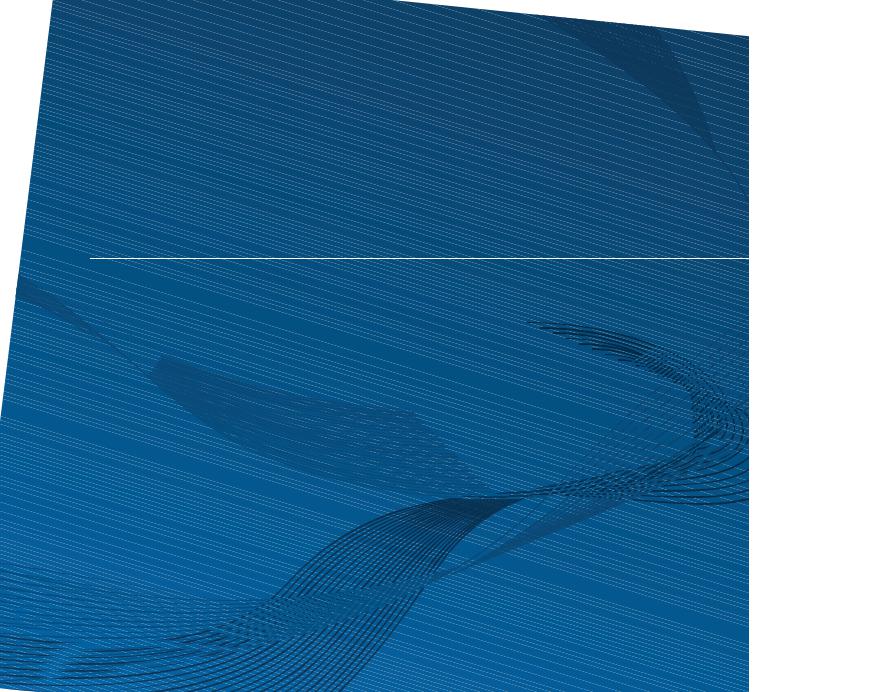
User’s Guide
ML-216x Series
ML-216xW Series
BASICIC
This guide provides information concerning installation, basic operation and troubleshooting on windows.
ADVANCED
This guide provides information about installation, advanced configuration, operation and troubleshooting on various OS environments.
Some features may not be available depending on models or countries.

BASIC
1. Introduction
Key benefits |
4 |
|
|
Features by models |
6 |
|
|
Useful to know |
8 |
|
|
About this user’s guide |
9 |
|
|
Safety information |
10 |
|
|
Machine overview |
15 |
|
|
|
|||
|
|
||
Control panel overview |
18 |
|
|
|
|
||
Turning on the machine |
20 |
|
|
Installing the driver locally |
21 |
|
|
Reinstalling the driver |
22 |
|
|
2. Menu overview and basic setup
Printing a demo page |
24 |
Media and tray |
25 |
Basic printing |
34 |
3. Maintenance
Ordering supplies and accessories |
38 |
Available supplies |
39 |
Available maintenance parts |
40 |
Storing the toner cartridge |
41 |
Redistributing toner |
43 |
Replacing the toner cartridge |
44 |
Cleaning the machine |
46 |
Tips for moving & storing your machine |
49 |
4. Troubleshooting |
|
Tips for avoiding paper jams |
51 |
Clearing paper jams |
52 |
Understanding the status LED |
55 |
5. Appendix
Specifications |
59 |
Regulatory information |
68 |
Copyright |
78 |
2

1. Introduction
This chapter provides information you need to know before using the machine.
• |
Key benefits |
4 |
• |
Features by models |
6 |
• |
Useful to know |
8 |
• About this user’s guide |
9 |
|
• |
Safety information |
10 |
• |
Machine overview |
15 |
• |
Control panel overview |
18 |
• Turning on the machine |
20 |
|
• Installing the driver locally |
21 |
|
• |
Reinstalling the driver |
22 |

Key benefits
Environmentally friendly |
Convenience |
|
|
|
|
|
|
|
•To save toner and paper, this machine supports the Eco feature (see "Easy Eco Driver" on page 158).
•To save paper, you can print multiple pages on a single sheet of paper (see "Using advanced print features" on page 140).
•To save paper, you can print on both sides of the paper (manual doublesided printing) (see "Using advanced print features" on page 140).
•To save electricity, this machine automatically conserves electricity by substantially reducing power consumption when not in use.
Print with excellent quality and speed
•You can print with a resolution of up to 1,200 x 1,200 dpi effective output.
•Fast, on-demand printing.
- For single-side printing, 20 ppm (A4) or 21 ppm (Letter).
•Easy Capture Manager allows you to easily edit and print whatever you captured using the Print Screen key on the keyboardG(see "Understanding Easy Capture Manager" on page 159).
•Samsung Easy Printer Manager and Samsung Printer Status (or Smart Panel) are a program that monitors and informs you of the machine’s status and allows you to customize the machine’s settings (see "Using Samsung Easy Printer Manager" on page 163).
•AnyWeb Print helps you screen-capture, preview, scrap, and print the screen more easily than when you use the ordinary program (see "Samsung AnyWeb Print" on page 157).
•Smart Update allows you to check for the latest software and install the latest version during the printer driver installation process. This is available only for Windows OS users.
•If you have Internet access, you can get help, support application, machine drivers, manuals, and order information from the Samsung website, www.samsung.com > find your product > Support or Downloads.

Key benefits
Wide range of functionality and application support
•Supports various paper sizes (see "Print media specifications" on page 61).
•Print watermark: You can customize your documents with words, such as “Confidential” (see "Using advanced print features" on page 140).
•Print posters: The text and pictures of each page of your document are magnified and printed across the multiple sheets of paper and can then be taped together to form a poster (see "Using advanced print features" on page 140).
•You can print in various operating systems (see "System requirements" on page 64).
•Your machine is equipped with a USB interface.
•Using the USB cable or a network cable
-You can connect and set various wireless network settings using a USB cable or a network cable.
•Using the Wi-Fi Direct
-You can conveniently print from your mobile device using the Wi-Fi or Wi-Fi Direct feature.
 See "Introducing wireless set up methods" on page 105.
See "Introducing wireless set up methods" on page 105.
Supports various wireless network setting method
•Using the WPS (Wi-Fi Protected Setup™) button
-You can easily connect to a wireless network using the WPS button on the machine and the access point (a wireless router).

Features by models
Some features and optional goods may not be available depending on model or country.
Operating System
Operating System |
ML-216x Series |
ML-216xW Series |
|
|
|
Windows |
|
|
|
|
|
Macintosh |
|
|
|
|
|
Linux |
|
|
|
|
|
Unix |
|
|
|
|
|
Software |
|
|
Software |
ML-216x Series |
ML-216xW Series |
|
|
|
PCL printer driver |
|
|
|
|
|
SPL printer driver |
|
|
|
|
|
PS printer driver |
|
|
|
|
|
XPS printer driver |
|
|
|
|
|
Samsung Easy Printer Manager |
|
|
|
|
|
SyncThru™ Web Service |
|
|
|
|
|
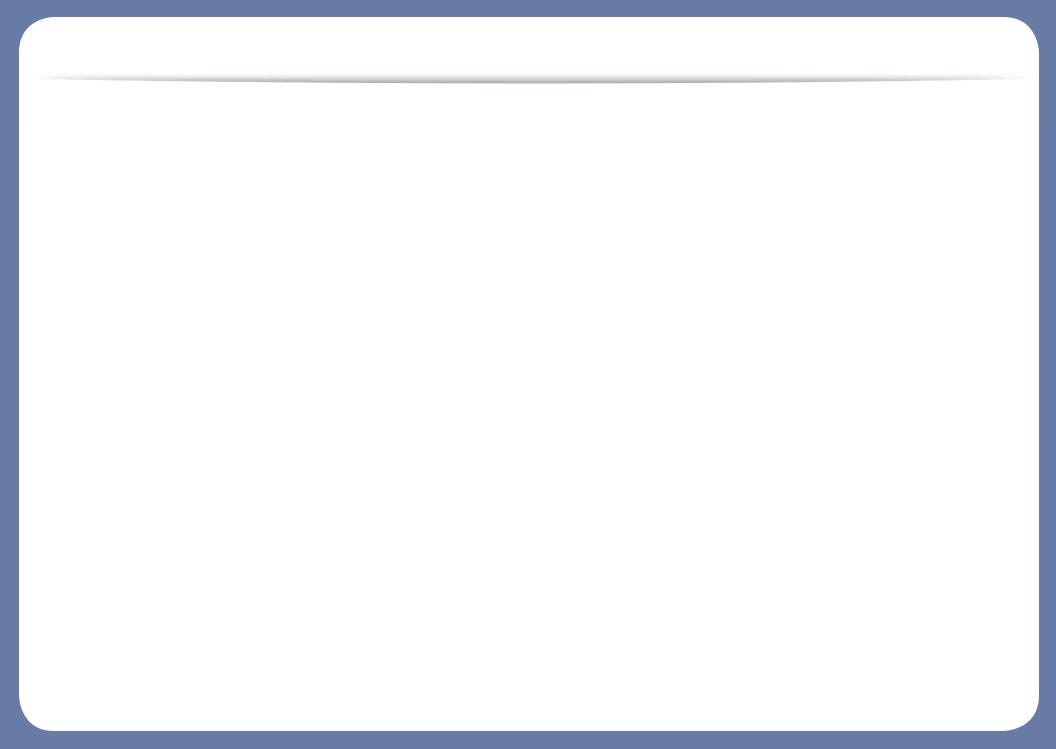
Features by models
Variety feature
Features |
ML-216x Series |
ML-216xW Series |
|
|
|
Hi-Speed USB 2.0 |
|
|
|
|
|
Network Interface Ethernet 10/100 Base TX wired LAN |
|
|
|
|
|
Network Interface 802.11b/g/n wireless LAN |
|
|
|
|
|
IPv6 |
|
|
|
|
|
Eco printing(Easy Eco Driver)a |
|
|
Wi-Fi Protected Setup™ (WPS) |
|
|
|
|
|
Manual duplex (2-sided) printing |
|
|
|
|
|
a. Setting the ECO settings is available from the windows driver.
( : Included, Blank: Not available)

Useful to know
Where can I download the machine’s driver?
•Visit www.samsung.com/printer to download the latest machine’s driver, and install it on your system.
Where can I purchase accessories or supplies?
•Inquire at a Samsung distributor or your retailer.
•Visit www.samsung.com/supplies. Select your country/region to view product service information.
The status LED flashes or remains constantly on.
•Turn the product off and on again.
•Check the meanings of LED indications in this manual and troubleshoot accordingly (see "Understanding the status LED" on page 55).
A paper jam has occurred.
•Open and close the top cover (see "Front view" on page 16).
•Check the instructions on removing jammed paper in this manual and troubleshoot accordingly (see "Clearing paper jams" on page 52).
Printouts are blurry.
•The toner level might be low or uneven. Shake the toner cartridge.
•Try a different print resolution setting.
•Replace the toner cartridge.
The machine does not print.
•Open the print queue list and remove the document from the list (see "Canceling a print job" on page 35).
•Remove the driver and install it again (see "Installing the driver locally" on page 21).
•Select your machine as your default machine in your Windows.

|
About this user’s guide |
|
|
This user's guide provides information for your basic understanding of the |
2 |
|
|
|
|
machine as well as detailed steps to explain machine usage. |
General icons |
|
• Read the safety information before using the machine. |
|
|
|
|
|
|
• If you have a problem using the machine, refer to the troubleshooting |
Icon |
Text |
Description |
|
chapter. |
||||
|
|
|
||
|
Caution |
Gives users information to protect the machine from |
||
• Terms used in this user’s guide are explained in the glossary chapter. |
|
|||
|
possible mechanical damage or malfunction. |
|||
|
|
|
•All illustrations in this user’s guide may differ from your machine depending
on its options or model you purchased. |
Note |
Provides additional information or detailed |
|
specification of the machine function and feature. |
|||
|
|||
|
|
•The screenshots in this user's guide may differ from your machine depending on the machine’s firmware/driver version.
•The procedures in this user’s guide are mainly based on Windows 7.
1
Conventions
Some terms in this guide are used interchangeably, as below:
•Document is synonymous with original.
•Paper is synonymous with media, or print media.
•Machine refers to printer or MFP.
1. Introduction |
9 |

 Safety information
Safety information
These warnings and precautions are included to prevent injury to you and others, and to prevent any potential damage to your machine. Be sure to read and understand all of these instructions before using the machine. After reading this section, keep it in a safe place for future reference.
3
Important safety symbols
Explanation of all icons and signs used in this chapter
Warning
Hazards or unsafe practices that may result in severe personal injury or death.
Caution
Hazards or unsafe practices that may result in minor personal injury or property damage.
Do not attempt.
4
Operating environment
 Warning
Warning
Do not use if the power cord is damaged or if the electrical outlet is not grounded.
This could result in electric shock or fire.
Do not place anything on top of the machine (water, small metal or heavy objects, candles, lit cigarettes, etc.).
This could result in electric shock or fire.
• If the machine gets overheated, it releases smoke, makes strange noises, or generates an odd odor, immediately turn off the power switch and unplug the machine.
•The user should be able to access the power outlet in case of emergencies that might require the user to pull the plug out.
This could result in electric shock or fire.
Do not bend, or place heavy objects on the power cord.
Stepping on or allowing the power cord to be crushed by a heavy object could result in electric shock or fire.
Do not remove the plug by pulling on the cord; do not handle the plug with wet hands.
This could result in electric shock or fire.
1. Introduction 10
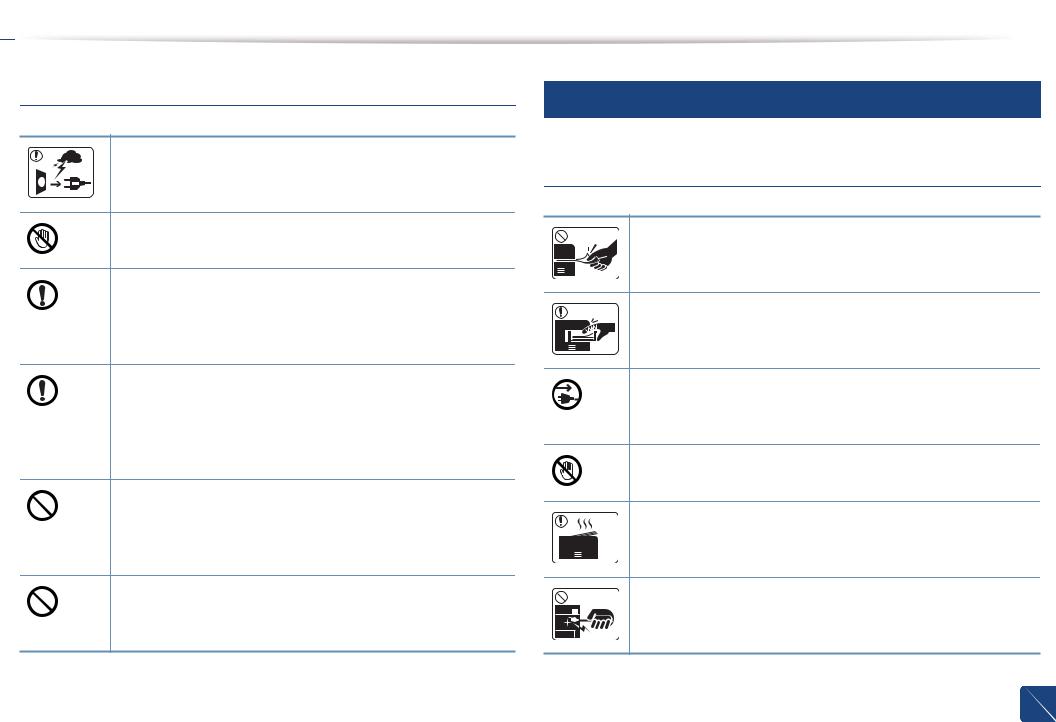
 Safety information
Safety information
 Caution
Caution
During an electrical storm or for a period of non-operation, remove the power plug from the electrical outlet.
This could result in electric shock or fire.
Be careful, the paper output area is hot.
Burns could occur.
If the machine has been dropped, or if the cabinet appears damaged, unplug the machine from all interface connections and request assistance from qualified service personnel.
Otherwise, this could result in electric shock or fire.
If the machine does not operate properly after these instructions have been followed, unplug the machine from all interface connections and request assistance from qualified service personnel.
Otherwise, this could result in electric shock or fire.
If the plug does not easily enter the electrical outlet, do not attempt to force it in.
Call an electrician to change the electrical outlet, or this could result in electric shock.
Do not allow pets to chew on the AC power, telephone or PC interface cords.
This could result in electric shock or fire and/or injury to your pet.
5
Operating method
 Caution
Caution
Do not forcefully pull the paper out during printing.
It can cause damage to the machine.
Be careful not to put your hand between the machine and paper tray.
You may get injured.
This machine's power reception device is the power cord.
To switch off the power supply, remove the power cord from the electrical outlet.
Be care when replacing paper or removing jammed paper.
New paper has sharp edges and can cause painful cuts.
When printing large quantities, the bottom part of the paper output area may get hot. Do not allow children to touch.
Burns can occur.
When removing jammed paper, do not use tweezers or sharp metal objects.
It can damage the machine.
1. Introduction 11
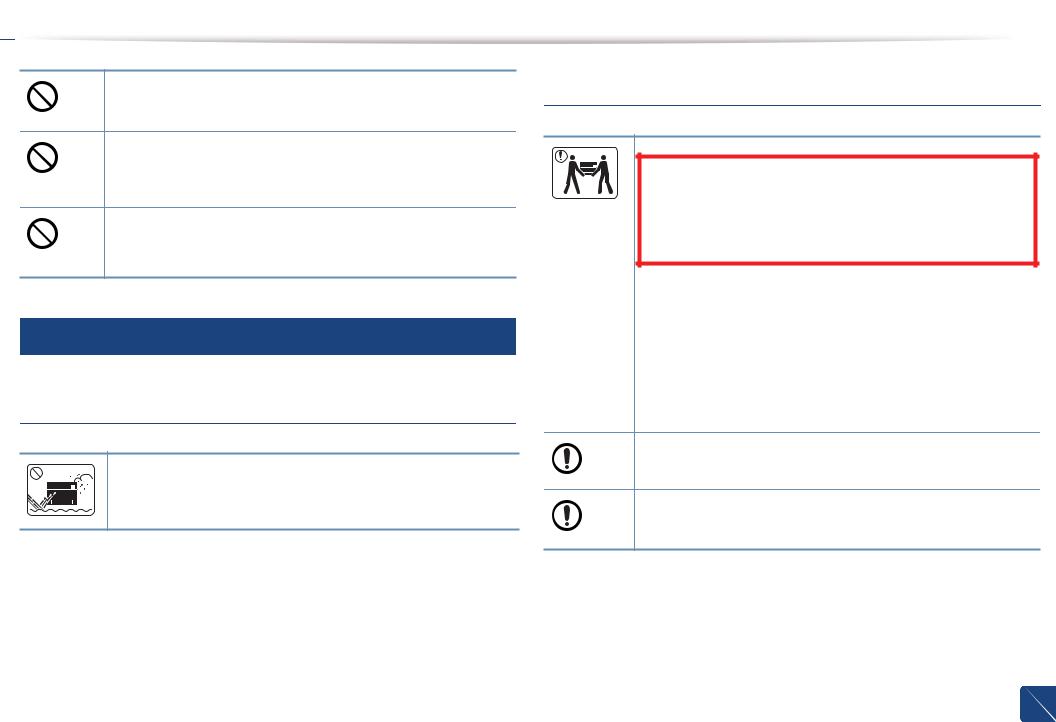
 Safety information
Safety information
Do not allow too many papers to stack up in the paper output tray.
It can damage the machine.
Do not block or push objects into the ventilation opening.
This could result in elevated component temperatures which can cause damage or fire.
Use of controls or adjustments or performance of procedures other than those specified herein may result in hazardous radiation exposure.
6
Installation / Moving
 Warning
Warning
Do not place the machine in an area with dust, humidity, or water leaks.
This could result in electric shock or fire.
 Caution
Caution
Before moving the machine, turn the power off and disconnect all
cords. The information below are only suggestions based on the units weight.
If you have a medical condition that prevents you from lifting, do not lift the machine. Ask for help, and always use the appropriate amount of people to left the device safety.
Then lift the machine:
•If the machine weighs under 20 kg (44.09 lbs), lift with 1 person.
•If the machine weighs 20 kg (44.09 lbs) - 40kg (88.18 lbs), lift with 2 people.
•If the machine weighs more than 40 kg (88.18 lbs), lift with 4 or more people.
The machine could fall, causing injury or machine damage.
Do not place the machine on an unstable surface.
The machine could fall, causing injury or machine damage.
Use only No.26 AWGa or larger, telephone line cord, if necessary.
Otherwise, it can cause damage to the machine.
1. Introduction 12
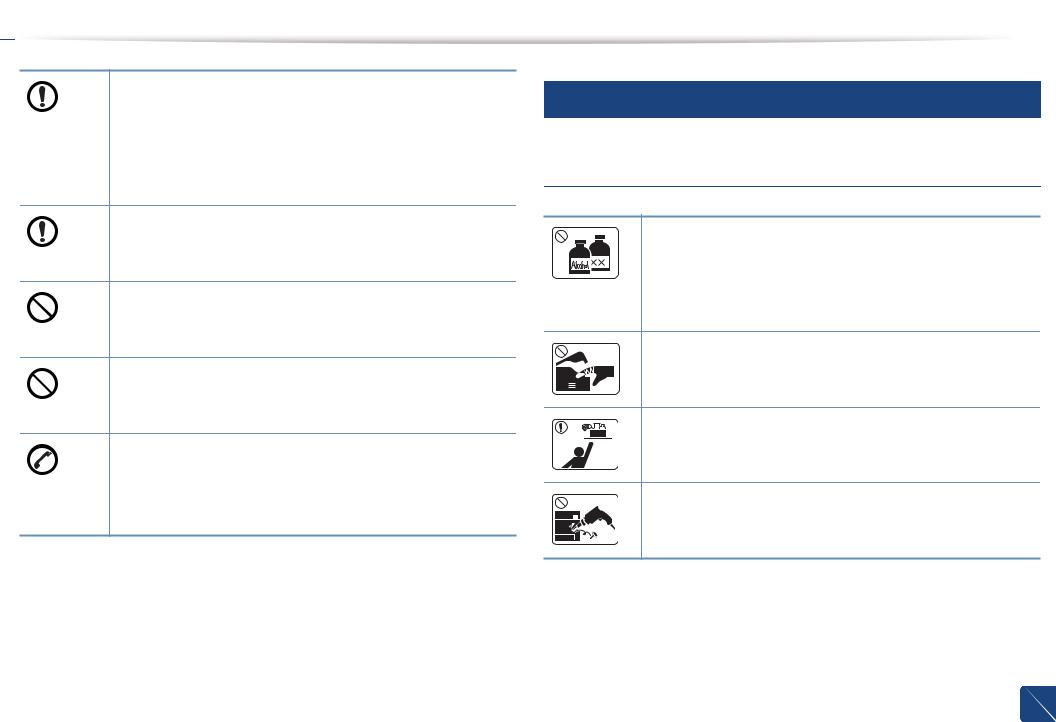
 Safety information
Safety information
Use the power cord supplied with your machine for safe operation. If you are using a cord which is longer than 2 meters (6 feet) with a 110 V machine, then the gauge should be 16 AWG or larger.
Otherwise, it can cause damage to the machine, and could result in electric shock or fire.
Make sure you plug the power cord into a grounded electrical outlet.
Otherwise, this could result in electric shock or fire.
Do not overload wall outlets and extension cords.
This can diminish performance, and could result in electric shock or fire.
Do not put a cover over the machine or place it in an airtight location, such as a closet.
If the machine is not well-ventilated, this could result in fire.
The machine should be connected to
the power level which is specified on the label.
If you are unsure and want to check the power level you are using, contact the electrical utility company.
a. AWG: American Wire Gauge
7
Maintenance / Checking
 Caution
Caution
Unplug this product from the wall outlet before cleaning the inside of the machine. Do not clean the machine with benzene, paint thinner or alcohol; do not spray water directly into the machine.
This could result in electric shock or fire.
When you are working inside the machine replacing supplies or cleaning the inside, do not operate the machine.
You could get injured.
Keep cleaning supplies away from children.
Children could get hurt.
Do not disassemble, repair or rebuild the machine by yourself.
It can damage the machine. Call a certified technician when the machine needs repairing.
1. Introduction 13

 Safety information
Safety information
• Do not remove any covers or guards that are fastened with screws.
•Fuser units should only be repaired by a certified service technician. Repair by non-certified technicians could result in fire or electric shock.
•The machine should only be repaired by a Samsung service technician.
To clean and operate the machine, strictly follow the user's guide provided with the machine.
Otherwise, you could damage the machine.
Keep the power cable and the contact surface of the plug clean from dust or water.
Otherwise, this could result in electric shock or fire.
8
Supply usage
 Caution
Caution
Do not disassemble the toner cartridge.
Toner dust can be dangerous if inhaled or ingested.
Do not burn any of the supplies such as toner cartridge or fuser unit.
This could cause an explosion or uncontrollable fire.
When storing supplies such as toner cartridges, keep them away from children.
Toner dust can be dangerous if inhaled or ingested.
When changing the toner cartridge or removing jammed paper, be careful not to let toner dust touch your body or clothes.
Toner dust can be dangerous if inhaled or ingested.
When toner gets on your clothing, do not use hot water to wash it.
Hot water sets toner into fabric. Use cold water.
Using recycled supplies, such as toner, can cause damage to the machine.
In case of damage due to the use of recycled supplies, a service fee will be charged.
1. Introduction 14

 Machine overview
Machine overview
9
Accessories
Power cord |
Quick installation guide |
Output stackera |
Software CDb |
Misc. accessoriesc |
a.Refer to the Quick Install Guide to attach the output stacker to the machine.
b.The software CD contains the printer drivers and software applications.
c.Miscellaneous accessories included with your machine may vary by country of purchase and specific model.
1. Introduction 15

 Machine overview
Machine overview
10
Front view
• This illustration may differ from your machine depending on its model.
• Some features and optional goods may not be available depending on model or country (see "Features by models" on page 6).
4 |
|
5 |
|
3 |
2 |
|
1 |
Control panel |
3 |
Tray |
5 |
Output support |
7 |
Toner cartridge |
|
|
|
|
|
|
|
|
2 |
Tray handle |
4 |
Output tray |
6 |
Top cover |
|
|
|
|
|
|
|
|
|
|
1. Introduction 16

 Machine overview
Machine overview
11
Rear view
• This illustration may differ from your machine depending on its model.
• Some features and optional goods may not be available depending on model or country (see "Features by models" on page 6).
1
2
1 |
USB port |
2 |
Power receptacle |
|
|
|
|
1. Introduction 17
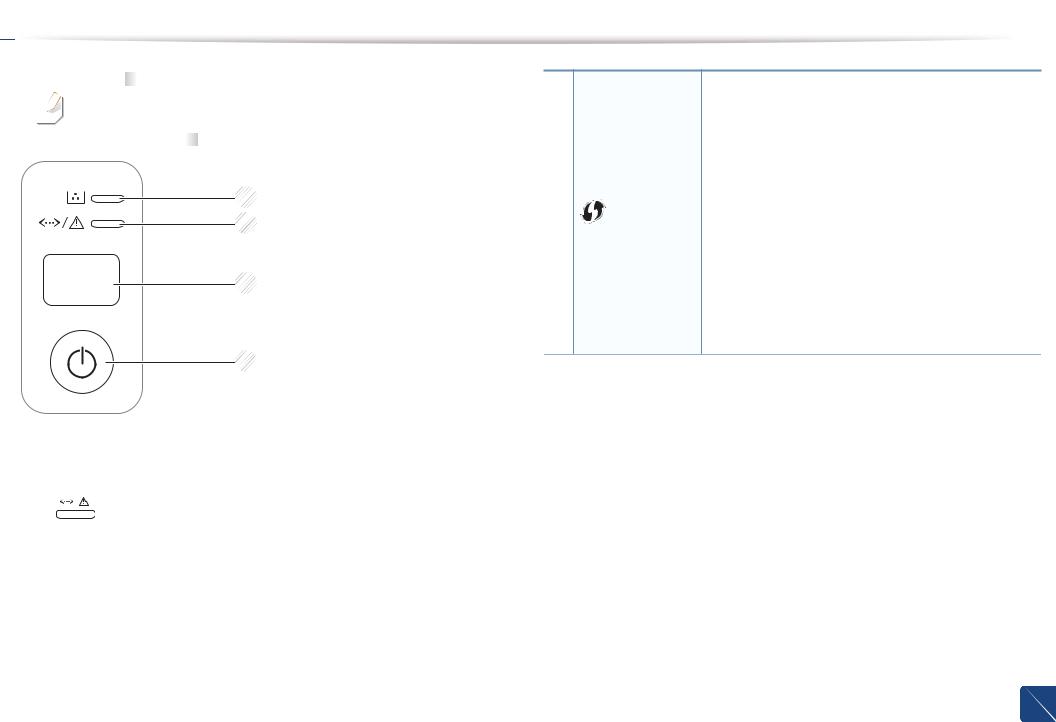
 Control panel overview
Control panel overview
This control panel may differ from your machine depending on its model. There are various types of control panels.
1
2
3
4
1 |
Toner LED |
Shows the status of the toner (see "Status LED" on page |
|
56). |
|
|
|
|
|
|
|
2 |
(Status |
Shows the status of your machine (see "Status LED" on |
|
page 56). |
|
|
LED) |
|
|
|
|
|
|
|
3 |
Configures the wireless network connection easily |
|
without a computer (see "Wireless network setup" on |
|
page 104). |
•configuration sheet
-Press and hold this button for about 10 seconds until the green LED blinks slowly, and release.
|
(WPS) |
• Prints supplies info report / error report |
|
|
|
|
|
-Press and hold this button for about 15 seconds until the green LED on, and release.
•Manual print
-Press this button each time you load a sheet of paper in the tray if you have selected Manual Feeder for Source in your printer driver.
1. Introduction 18
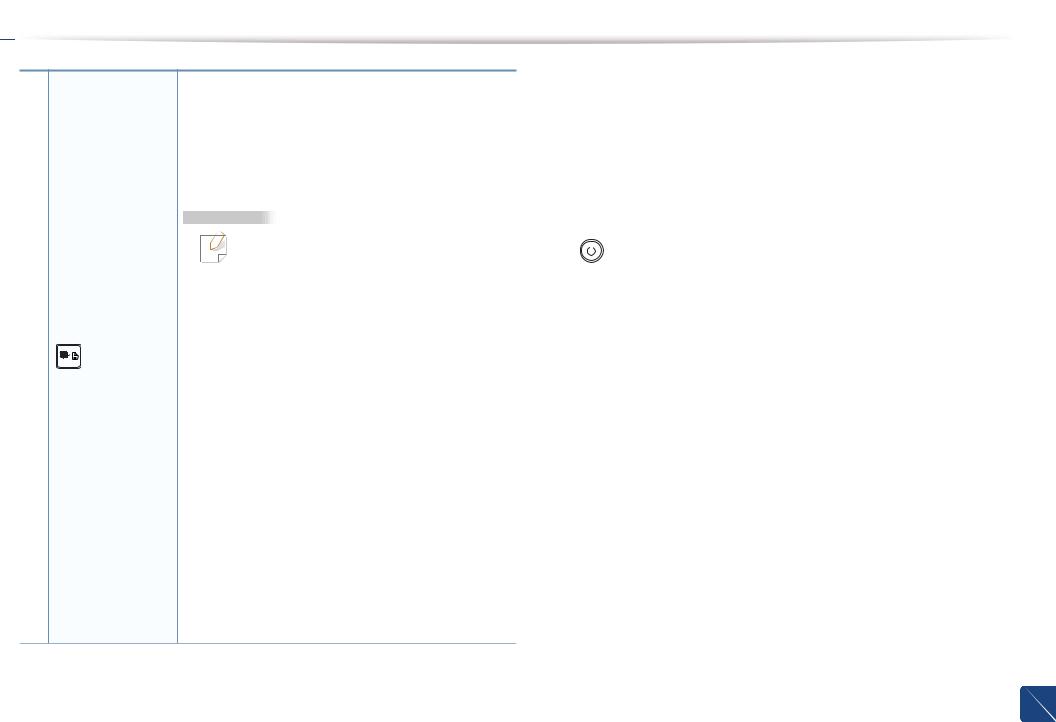
 Control panel overview
Control panel overview
3 |
• Prints the screen |
|
|
|
|
|
• Prints supplies info report / error report |
|
- Press this button and the green LED will start |
|
|
|
|
|
- Press and hold this button for about 15 seconds |
|
blinking. If you want to print only the active |
|
|
|
|
|
until the green LED on, and release. |
|
screen, release the button when the green LED |
|
|
|
|
|
• Manual print |
|
stops blinking. If you want to print the whole |
|
|
|
|
|
|
|
|
|
|
|
|
- Press this button each time you load a sheet of |
|
|
screen, release the button while it’s blinking. |
|
|
|
|
|
|
|
|
|
|
|
|
paper in the tray if you have selected Manual |
|
|
|
|
|
|
|
|
|
|
|
|
|
|
|
|
Feeder for Source in your printer driver. |
|
• Print Screen can only be used in the |
|
|
|
|
|
|
|
4 |
|
|
|
|
You can turn the power off or wake the machine up |
|
|
Windows and Macintosh operating |
|
|
|
(Power) |
||
|
|
|
|
|
from the sleep mode with this button. |
||
|
|
|
|
|
|||
|
systems. |
|
|
|
|
||
|
|
|
|
|
|
|
•You can only use this function with USBconnected machine.
•When printing the active window/whole
|
(Print screen) |
monitor screen using the print screen |
|
button, the machine may use more toner |
|
|
||
|
|
|
|
|
depending on what is being printed. |
•You can only use this function if the machine’s Easy Printer Manager program is installed if you are a macintosh OS user, you need to enable Screen Print Settings from the Easy Printer Manager to use the Print Screen feature.
•configuration sheet
-Press and hold this button for about 10 seconds until the green LED blinks slowly, and release.
1. Introduction 19

 Turning on the machine
Turning on the machine
1Connect the machine to the electricity supply first.
2
1
2press  (power) on the control panel.
(power) on the control panel.
If you want to turn the power off, press  (power) on the control panel.
(power) on the control panel.
1. Introduction 20

 Installing the driver locally
Installing the driver locally
A locally connected machine is a machine directly attached to your computer |
2 |
|
|
using the cable. If your machine is attached to a network, skip the following |
|
steps below and go on to installing a network connected machine’s driver (see |
|
Advanced Guide). |
|
|
3 |
• If you are a Macintosh or Linux OS user, refer to the "Software installation" on page 82.
•The installation window in this User’s Guide may differ depending on the machine and interface in use.
•Selecting Custom Installation allows you to choose which programs to install.
•Only use a USB cable no longer than 3 meters (118 inches).
12
Windows
1Make sure that the machine is connected to your computer and powered on.
If the “Found New Hardware Wizard” appears during the installation procedure, click Cancel to close the window.
Insert the supplied software CD into your CD-ROM drive.
The software CD should automatically run and an installation window will appear.
Select Install Now.
4Read License Agreement, and select I accept the terms of the License Agreement. Then, click Next.
5Follow the instructions in the installation window.
1. Introduction 21
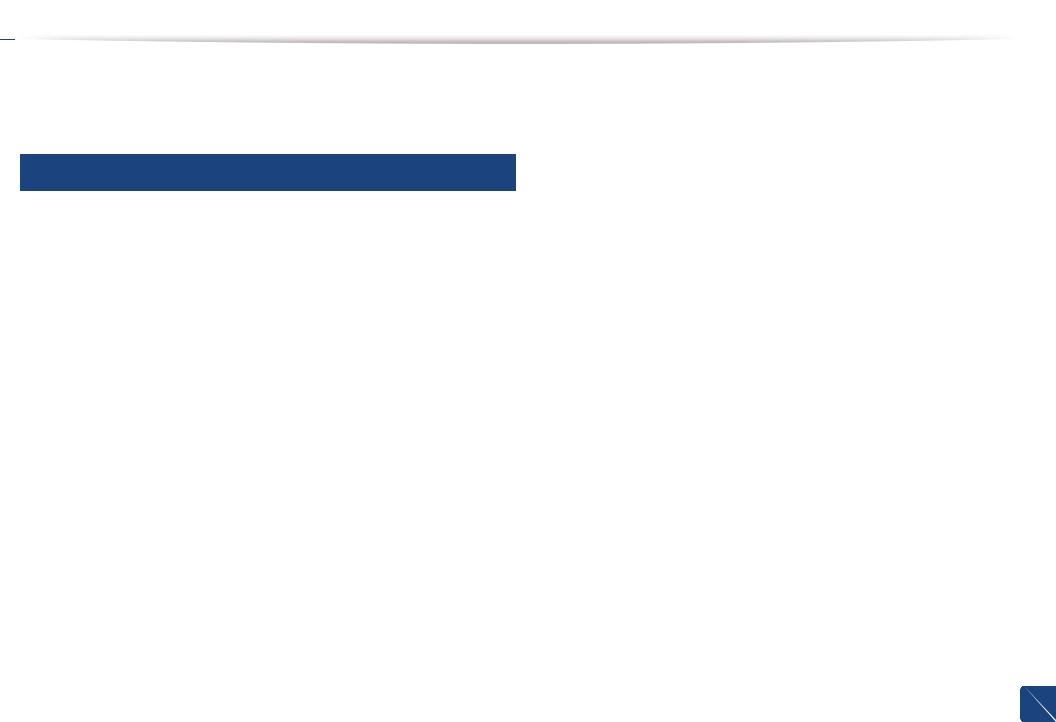
 Reinstalling the driver
Reinstalling the driver
If the printer driver does not work properly, follow the steps below to reinstall the driver.
13
Windows
1Make sure that the machine is connected to your computer and powered on.
2
3
4
From the Start menu, select Programs or All Programs > Samsung Printers > your printer driver name > Uninstall.
Follow the instructions in the installation window.
Insert the software CD into your CD-ROM drive and install the driver again (see "Installing the driver locally" on page 21).
1. Introduction 22

2. Menu overview and basic
setup
After installation is complete, you may want to set the machine’s default settings. Refer to the next section if you would like to set or change values. This chapter provides information about the overall menu structure and the basic setup options.
• Printing a demo page |
24 |
|
• |
Media and tray |
25 |
• |
Basic printing |
34 |

 Printing a demo page
Printing a demo page
Print a demo page to make sure that the machine is operating correctly (Windows only).
To print a demo page:
•Open the Printing Preferences (see "Opening printing preferences" on page 35) > Samsung tab > Demo page
2. Menu overview and basic setup 24

 Media and tray
Media and tray
This chapter provides information on how to load print media into your machine.
• Using print media that does not meet these specifications may cause problems or require repairs. Such repairs are not covered by Samsung’s warranty or service agreements.
•Make sure not to use the inkjet photo paper with this machine. It could cause damage to the machine.
• Using inflammable print media can cause a fire. |
2 |
|
•Use designated print mediaG(see "Print media specifications" on page 61).
The use of inflammable media or foreign materials left in the printer may lead to overheating of the unit andS in rare cases may cause a fire.
1
Tray overview
To change the size, you need to adjust the paper guide.
1 |
1 |
Paper width guide |
2 |
Tray |
If you do not adjust the guide, it may cause paper registration, image skew, or jamming of the paper.
2. Menu overview and basic setup 25

Media and tray
2 |
3 |
Place the paper with the side you want to print facing up and |
|
Loading paper in the tray |
open the output tray. |
|
1 Open the tray. Then, adjust the tray size to the media size you are |
|
|
loading (see "Tray overview" on page 25). |
|
|
|
2 |
1
1
2
2Flex or fan the edge of the paper stack to separate the pages before loading papers.

Media and tray
4 Squeeze the paper width guide and slide it to the edge of the paper |
5 When you print a document, set the paper type and size for the tray |
stack without causing it to bend. |
(see "Setting the paper size and type" on page 33). |
The settings made from the machine driver override the settings on the control panel.
a To print in application, open an application and start the print menu.
b Open Printing Preferences (see "Opening printing preferences" on page 35).
c Press the Paper tab in Printing Preferences, and select an appropriate paper type.
For example, if you want to use a label, set the paper type to Label. d Select Manual Feeder in paper source, then press OK.
e Start printing in application.
• Do not push the paper width guide too far causing the media to warp.
•Do not use a paper with a leading-edge curl, it may cause a paper jam or the paper can be wrinkled.
•If you do not adjust the paper width guide, it may cause paper jams.

Media and tray
3
Manual feeding in the tray
The manual feeder can hold special sizes and types of print material, such as postcards, note cards, and envelopes (see "Print media specifications" on page 61).
•When printing on special media, you must follow the loading guidelines (see "Printing on special media" on page 28).
•When the machine is in a power save mode, the machine does not feed paper from the manual feeder. Wake up the machine by pressing the power button before using the manual feeder.
Tips on using the manual feeder
• Load only one type, size and weight of print media at time in the manual feeder.
• If you select Paper > Source > Manual Feeder for the paper source in your software application, you need to press  (Print
(Print
screen) or |
(WPS) button each time you print a page and load |
|
|
only one type, size and weight of print media at a time on the |
|
||
manual tray. |
|
|
|
• To prevent paper jams, do not add paper while printing when |
|
||
there is still paper in the manual feeder. |
|
||
• Print media should be loaded face up with the top edge going into |
|
||
the manual feeder first and be placed in the center of the tray. |
|
||
• To ensure printing quality and to prevent paper jams, only load the |
4 |
||
available paper (see "Print media specifications" on page 61). |
Printing on special media |
||
• Flatten any curl on postcards, envelopes, and labels before loading |
|||
|
|||
them into the manual feeder. |
|
||
The table below shows the special media usable in each tray.

 Media and tray
Media and tray
The media types are shown in the Printing Preferences. To get the higest printing quality, select the proper media type from the Printing Preferences window > Paper tab > Paper Type (see "Opening printing preferences" on page 35).
For example, if you want to print on labels, select Labels for Paper Type.
When using special media, we recommend you feed one sheet at a time (see "Print media specifications" on page 61).
To see for paper weights for each sheet, refer to "Print media specifications" on page 61.
Types |
Traya |
Plain |
|
|
|
Thick |
|
|
|
Thin |
|
|
|
Bond |
|
|
|
Color |
|
|
|
CardStock |
|
|
|
Labels |
|
|
|
Envelope |
|
|
|
Types |
Traya |
Preprinted |
|
|
|
Cotton |
|
|
|
Recycled |
|
|
|
Archive |
|
|
|
a. The paper types available manual feeding in tray.
( : Included, Blank: Not available)
Envelope
Printing successfully on envelopes depends upon the quality of the envelopes.
2. Menu overview and basic setup 29
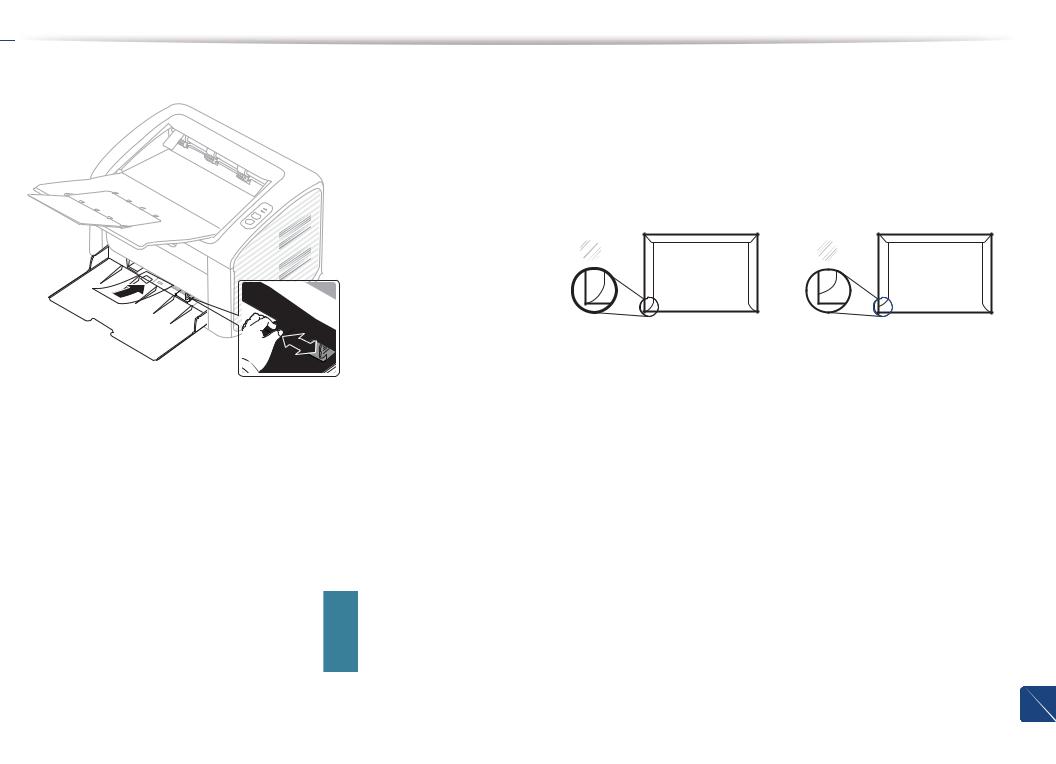
 Media and tray
Media and tray
To print an envelope, place it as shown in the following figure.
If you select Envelope from the Printing Preferences window, but the printed images get easily erased, select Thick Envelope and try printing again. However, this might cause some noise when printing.
•When selecting envelopes, consider the following factors:
-Weight: should not exceed 90 g/m2 otherwise; jams may occur.
-Construction: should lie flat with less than 6 mm curl and should not contain air.
-Condition: should not be wrinkled, nicked, nor damaged.
-Temperature: should resist the heat and pressure of the machine during operation.
•Use only well-constructed envelopes with sharp and well-creased folds.
•Do not use stamped envelopes.
•Do not use envelopes with clasps, snaps, windows, coated lining, selfadhesive seals, or other synthetic materials.
•Do not use damaged or poorly made envelopes.
•Be sure the seam at both ends of the envelope extends all the way to the corner of the envelope.
1 |
2 |
1 |
Acceptable |
2 |
Unacceptable |
•Envelopes with a peel-off adhesive strip or with more than one flap that folds over to seal must use adhesives compatible with the machine’s fusing temperature for 0.1 second (about 170°C (338 °F)). The extra flaps and strips might cause wrinkling, creasing, or jams, and may even damage the fuser.
•For the best print quality, position margins no closer than 15 mm from the edges of the envelope.
•Avoid printing over the area where the envelope’s seams meet.
2. Menu overview and basic setup 30
